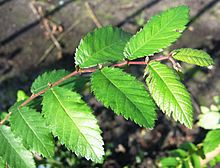Ulmus alata
| Winged elm | |
|---|---|
 |
|
| Leaves | |
| Scientific classification | |
| Kingdom: | Plantae |
| (unranked): | Angiosperms |
| (unranked): | Eudicots |
| (unranked): | Rosids |
| Order: | Rosales |
| Family: | Ulmaceae |
| Genus: | Ulmus |
| Species: | U. alata |
| Binomial name | |
|
Ulmus alata Michx. |
|
 |
|
| Natural range | |
| Synonyms | |
|
|
Ulmus alata, the winged elm or wahoo, is a small- to medium-sized deciduous tree endemic to the woodlands of the southeastern and south-central United States. The species is tolerant of a wide range of soils, and of ponding, but is the least shade-tolerant of the North American elms. Its growth rate is often very slow, the trunk increasing in diameter by less than 5 mm (3⁄16 in) per year. The tree is occasionally considered a nuisance as it readily invades old fields, forest clearings, and rangelands, proving particularly difficult to eradicate with herbicides.
As its common and scientific names imply, winged elm is most easily recognized by the very broad, thin pair of corky wings that form along the branchlets after a couple of years. The tree generally grows to a maximum height and breadth of about 13 m × 13 m (43 ft × 43 ft), although on fertile alluvial soils such as those of the Mississippi River Delta, some specimens have reached double this height (see 'Notable trees' below). The crown can be either rounded or pyramidal; the branches are pendulous.
The leaves are comparatively small for the genus, less than 6.5 cm (2 1⁄2 in) long and less than 2.0 cm (3⁄4 in) broad, oblong-lanceolate to narrowly elliptic, thin in texture, and smooth above. The wind-pollinated perfect apetalous flowers are borne on long pedicels in March and April before the leaves appear. The reddish samaras are also relatively small, less than 8 mm (5⁄16 in) long, narrowly elliptic with two long incurving stigmas at the tip, and usually disperse before the end of April.
Like the other North American species of elm, U. alata is very susceptible to Dutch elm disease and Elm Yellows (Elm phloem necrosis).
Ulmus alata is rarely cultivated beyond its natural range. It remains in commercial production in the USA, and is occasionally available in Europe; several specimens are also grown in New Zealand.
...
Wikipedia
